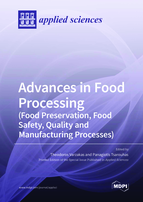Advances in Food Processing (Food Preservation, Food Safety, Quality and Manufacturing Processes)
A special issue of Applied Sciences (ISSN 2076-3417). This special issue belongs to the section "Food Science and Technology".
Deadline for manuscript submissions: closed (31 March 2021) | Viewed by 48497
Special Issue Editors
Interests: food technology; food engineering; food safety; food quality; extra virgin olive oil; mycotoxins; fermented foods
Special Issues, Collections and Topics in MDPI journals
Interests: reliability analysis; machinery maintenance; overall equipment effectiveness; industrial automation; maintenance management; production/operations management
Special Issues, Collections and Topics in MDPI journals
Special Issue Information
Dear Colleagues,
The aim of this Special Issue is to bring the most updated information on the most common and new food manufacturing processes while addressing relevant food safety and quality issues. It will also address issues on the design of food processing operations and the necessary equipment, along with reliability, safety, and maintainability management tools.
Different food manufacturing processes can include products of plant and animal origin, such as dairy, bakery and confectionery, fruits and vegetables, nonalcoholic and alcoholic beverages, chocolate, oils and fats, meat, poultry, seafood, snacks, and functional foods.
It will also examine food quality and safety requirements throughout, including hygiene and food sanitation, ISO22000, HACCP, sensory evaluation of foods, and food waste management.
Highlights:
- Hygiene and food sanitation;
- Case studies on the implementation of ISO22000, HACCP, and other management tools such as failure mode and effect analysis (FMEA), Pareto, and Ishikawa for the implementation of food safety/traceability;
- Food waste management case studies from the food industry along with life cycle analysis and circular economy;
The aim of this Special Issue is to attract papers in the general area of food processing while also addressing issues on quality and food safety, incorporating all the aforementioned principles.
Prof. Dr. Theodoros Varzakas
Prof. Dr. Panagiotis Tsarouhas
Guest Editors
Manuscript Submission Information
Manuscripts should be submitted online at www.mdpi.com by registering and logging in to this website. Once you are registered, click here to go to the submission form. Manuscripts can be submitted until the deadline. All submissions that pass pre-check are peer-reviewed. Accepted papers will be published continuously in the journal (as soon as accepted) and will be listed together on the special issue website. Research articles, review articles as well as short communications are invited. For planned papers, a title and short abstract (about 100 words) can be sent to the Editorial Office for announcement on this website.
Submitted manuscripts should not have been published previously, nor be under consideration for publication elsewhere (except conference proceedings papers). All manuscripts are thoroughly refereed through a single-blind peer-review process. A guide for authors and other relevant information for submission of manuscripts is available on the Instructions for Authors page. Applied Sciences is an international peer-reviewed open access semimonthly journal published by MDPI.
Please visit the Instructions for Authors page before submitting a manuscript. The Article Processing Charge (APC) for publication in this open access journal is 2400 CHF (Swiss Francs). Submitted papers should be well formatted and use good English. Authors may use MDPI's English editing service prior to publication or during author revisions.
Keywords
- food processing
- preservation
- food quality and safety management
- food manufacturing
- supply chain management
- LCA
- circular economy
- reliability and maintainability management







